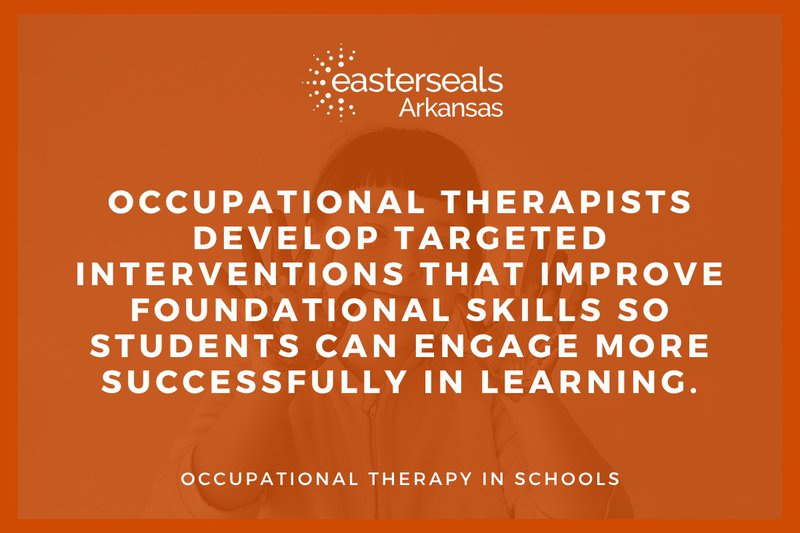
When occupational therapy in schools helps your child write more clearly, stay focused during lessons, or manage big emotions in the classroom, it transforms their entire school experience. Your child sits at their desk, struggling to copy notes from the board while classmates finish quickly. They fidget constantly during circle time, unable to sit still long enough to participate. How can school-based occupational therapy (OT) address these specific struggles? What does the qualification process actually involve? How will therapy services fit into your child's school day?
Key Takeaways:
- Occupational therapy (OT) in schools supports essential skills like handwriting, focus, movement coordination, and emotional regulation needed for classroom success.
- School-based occupational therapists assess student needs, develop measurable goals, deliver therapy interventions, and train school staff on implementation strategies.
- OT services become part of Individualized Education Programs (IEPs) for students in special education or 504 plans for students who need accommodations in general education settings.
- Qualification depends on how a challenge impacts educational performance rather than diagnosis alone, determined through either IDEA or Section 504 regulations.
- Common interventions target fine and gross motor development, sensory processing needs, classroom participation strategies, and handwriting skills through evidence-based approaches.
- Strong collaboration between occupational therapists, teachers, and parents creates consistency across environments and accelerates student progress toward independence.
Understanding Occupational Therapy in Schools
Occupational therapy in schools helps students participate fully in educational activities that define their school day. This includes writing assignments, reading independently, transitioning between classes, eating lunch in the cafeteria, playing during recess, and maintaining focus during instruction.
Therapists evaluate how children use their hands for detailed tasks, move their bodies through space, respond to sensory input from their environment, and manage their emotions throughout the day. They develop targeted interventions that improve these foundational skills so students can engage more successfully in learning. Licensed occupational therapists observe students in multiple settings, gather input from teachers and families, and identify evidence-based strategies that support each child's unique needs.
An occupational therapist may work with a student individually, lead small groups addressing shared goals, or provide support during regular classroom activities. Many school OTs also train teachers and staff to implement accommodations like movement cushions, fidget tools, or visual schedules.
School occupational therapy focuses specifically on educational access rather than medical treatment. School OTs help students develop skills directly tied to classroom success, such as cutting with scissors during art projects, taking notes during lectures, or participating appropriately during recess. Clinic-based occupational therapists tend to address broader functional goals related to daily self-care or health outcomes. Both service models support student growth, but each is specifically tailored to the child's primary environment.
Qualifying for Occupational Therapy in Schools
A student qualifies for school-based occupational therapy when a health condition or learning difference creates barriers to educational success. Qualification centers on how the challenge affects educational performance rather than medical needs alone.
Students qualify for services when their challenges meet criteria under either IDEA or Section 504 regulations. IDEA (Individuals with Disabilities Education Act) supports students who require specialized instruction, covering conditions including autism spectrum disorder, attention-deficit/hyperactivity disorder, traumatic brain injury, and cerebral palsy. Section 504 supports students with disabilities who don't require specialized instruction but need accommodations to access their educational programs.
The evaluation process typically begins when a parent or teacher observes a child struggling with essential tasks like writing legibly, managing clothing fasteners, or sustaining attention during instruction. A school-based team discusses whether an OT evaluation is appropriate. A licensed school occupational therapist then completes a comprehensive assessment that includes observing the student, collecting input from teachers and families, and administering standardized tests.
Common assessment tools include the Beery-Buktenica Test of Visual-Motor Integration (Beery VMI) for eye-hand coordination, the Bruininks-Oseretsky Test of Motor Proficiency (BOT-2) for motor skills, and the Sensory Processing Measure (SPM) for sensory responses. If assessment findings demonstrate that challenges significantly affect educational performance and therapy would provide meaningful benefit, services begin through an IEP or 504 plan.
Common Occupational Therapy Interventions in Schools
Occupational therapists use targeted movement activities, deep pressure tools, and strategic modifications to sensory input to help students maintain optimal focus and regulation. Noise-canceling headphones reduce auditory distractions in busy classrooms. Designated quiet corners provide spaces for students to reset when overwhelmed. Some students benefit from deep pressure through weighted vests or compression clothing.
Therapists use play-based activities and hands-on tasks to build students' physical control and coordination. Students strengthen small hand muscles through engaging activities like squeezing clay, using tongs to sort small objects, or manipulating putty. Gross motor interventions include balancing games, stair climbing practice, or exercises that develop the strength needed to sit upright at a desk.
| Challenge Area | Common Signs | OT Interventions |
|---|---|---|
| Fine Motor Weakness | Poor pencil control, hand fatigue, difficulty with scissors | Strengthening activities with clay, tweezers, or clothespins; adaptive grips |
| Visual-Motor Integration | Trouble copying from board, spacing issues, letter reversals | Tracing tasks, vertical surface writing, visual-motor games |
| Sensory Processing | Difficulty focusing, avoiding touch, overreacting to noise | Movement breaks, weighted tools, noise-canceling headphones, quiet spaces |
Occupational therapists adapt tasks, recommend appropriate tools, and teach compensatory strategies so all students can remain actively involved in learning activities. Flexible seating options like wobble cushions help students who need movement to maintain attention. Visual timers or step-by-step picture guides support children who lose track of multi-step procedures.
Supporting Students with Autism and ADHD
Occupational therapy in schools helps students with autism spectrum disorder and attention-deficit/hyperactivity disorder manage emotions effectively, maintain engagement in learning activities, and establish productive daily routines.
Occupational therapists implement deep pressure tools, visual supports, and routine modifications to help students with autism feel regulated and comfortable. Visual schedules break the school day into predictable, manageable segments that reduce anxiety about transitions. Some students benefit from a "sensory diet," which is a personalized schedule of sensory activities strategically placed throughout the day.
Therapists add movement-friendly seating, clear visual schedules, and brief active breaks to help students with ADHD maintain attention and regulate their energy. Wobble cushions allow quiet movement while seated without disrupting instruction. Brief brain breaks, incorporating jumping jacks, stretching, or walking help reset mental focus before returning to challenging academic tasks.
Collaboration Between Therapists, Teachers, and Parents
School-based occupational therapists regularly communicate with classroom teachers about effective tools, observable behaviors, and evidence-based strategies that support each student's participation. Teachers learn the underlying reasons why particular accommodations support student success and when to implement them for maximum benefit.
Parents share detailed information about the everyday challenges their children face at home and in community settings. This real-world context helps therapists establish truly functional goals. Regular updates from occupational therapists keep families informed and engaged. Consistency between home and school environments significantly accelerates student progress.
Frequently Asked Questions About Occupational Therapy in Schools

How long does occupational therapy take to show results in school?
Progress timelines vary significantly based on each student's unique needs, the specific skills being addressed, and intervention intensity. Some students show noticeable improvement in targeted skills within several weeks of consistent therapy. More complex goals involving sensory processing, emotional regulation, or motor planning may require months of intervention before substantial changes become evident.
Can occupational therapy help with behavioral issues at school?
Yes, when behavioral challenges stem from underlying sensory processing difficulties, motor skill deficits, or executive functioning weaknesses. Occupational therapists identify root causes of behaviors that interfere with learning. Therapists implement proactive strategies addressing underlying needs before behaviors escalate, including sensory breaks, modified seating, visual schedules, or environmental changes.
What is the difference between occupational therapy and physical therapy in schools?
Occupational therapy in schools focuses on fine motor skills, visual-motor integration, sensory processing, and activities of daily living that directly affect classroom participation. Physical therapy emphasizes gross motor skills, mobility, strength, and endurance, affecting safe movement through school environments. Some students receive both therapies when they need comprehensive support.
Practical Steps for Accessing Occupational Therapy Services
Step One: Document Specific Concerns and Examples
Begin by keeping detailed notes about specific situations where your child struggles at school. Record concrete examples, including the date, activity, what happened, and how your child responded. Photograph work samples showing handwriting concerns or organizational difficulties. This documentation provides valuable information when discussing your child's needs with school staff.
Step Two: Request a Meeting and Formal Evaluation
Contact your child's teacher or school principal to request a meeting to discuss your concerns. Put your request in writing, clearly stating that you would like the school to evaluate whether your child needs occupational therapy services. Schools must respond to written evaluation requests within specific timelines established by federal and state regulations.
Step Three: Participate Actively in the IEP or 504 Planning Process
Once evaluation results are available, you'll meet with the school team to review findings and determine appropriate services. Come prepared with questions about specific strategies, how often therapy will occur, and what goals make sense for your child. Ask how you can support therapy goals at home and how the team will measure progress.
Compassionate Support for Students and Families at Easterseals Arkansas
Every student deserves the opportunity to participate fully in their education, regardless of the challenges they face. When underlying motor, sensory, or regulation difficulties create barriers to learning, targeted occupational therapy intervention helps students develop the skills they need to succeed.
At Easterseals Arkansas, we connect families to comprehensive resources supporting children's development and school success. Our evidence-based approaches emphasize collaboration between families, schools, and community professionals. We believe in building on each child's unique strengths while addressing areas of need through individualized, compassionate support.
We understand that navigating school-based services can feel complex and overwhelming for families. Whether you're just beginning to have concerns about your child's school performance or you're actively working with an IEP team, we're here to help you understand your options and advocate effectively. Contact Easterseals Arkansas to learn more about our programs supporting children's development, family resources, and connections to school-based services.
